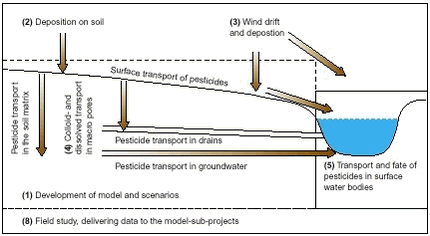| Front page | | Contents | | Next |
Pesticides in streams and subsurface drainage water within two arable catchments in Denmark: Pesticide application, concentration, transport and fate
Preface
The project ”Model Based Tool for Evaluation of Exposure and Effects of Pesticides in Surface Water” funded by the Danish Environmental Protection Agency was initiated in 1998. The aim of the project was:
To develop a model-based tool for evaluation of risks related to pesticide exposure in surface water. The tool must be directly applicable by the Danish Environmental Protection Agency (DEPA) in their approval procedure. As part of this goal, the project had to:
- Develop guidelines for evaluation of mesocosm experiments based on a system-level perspective of the freshwater environment
- Develop models for deposition of pesticides on vegetation and soil
- Estimate atmospheric pesticide deposition on the aquatic environment.
The project called ”Pesticides in Surface Water” consisted of seven subprojects with individual objectives. The sub-projects are listed in Table i.
Table i.
Sub-projects of ”Pesticides in Surface Water”.
Tabel i.
Oversigt over delprojekter i ”Pesticider i overfladevand”.
| |
Title |
Participating institutions |
| A |
Development and validation of a model for evaluation of pesticide exposure |
DHI Water & Environment |
| B |
Investigation of the importance of plant cover for the deposition of pesticides on soil |
Danish Institute of Agricultural Science
|
| C |
Estimation of addition of pesticides to surface water via air
|
National Environmental Research Institute
Danish Institute of Agricultural Science |
| D |
Facilitated transport |
DHI Water & Environment |
| E |
Development of an operational and validated model for pesticide transport and fate in surface water
|
DHI Water & Environment
National Environmental Research Institute |
| F |
Mesocosm |
DHI Water & Environment
National Environmental Research Institute |
| G |
Importance of different transport routes in relation to occurrence and effects of pesticides in streams |
National Environmental Research Institute
County of Funen
County of Northern Jutland |
Figure i describes the relationship between the sub-projects. Sub-project 1 models the upland part of the catchment, while sub-project 5 models surface water bodies. Sub-project 8 delivers data to both modelling projects. Subprojects 2 and 3 develop process descriptions for wind drift, dry deposition and deposition on soils. Sub-project 4 builds and tests a module for calculation of colloid transport of pesticides in soil. The module is an integrated part of the upland model. Sub-project 6 has mainly concentrated on interpretation of mesocosm-studies. However, it contains elements of possible links between exposure and biological effects.

Figure i.
Links between the different sub-projects. The sub-projects are illustrated on a cross-section of the catchment to illustrate interactions.
Figur i.
Sammenhæng mellem delprojekterne. Delprojekterne er placeret på et tværsnit af et opland for at illustrere interaktionerne.
The reports produced by the project are:
- Styczen, M., Petersen, S., Christensen, M., Jessen, O.Z., Rasmussen, D., Andersen, M.B. and Sørensen, P.B. (2002): Calibration of models describing pesticide fate and transport in Lillebæk and Odder Bæk Catchment. - Ministry of the Environment, Danish Environmental Protection Agency, Pesticides Research No. 62.
- Styczen, M., Petersen, S. and Sørensen, P.B. (2002): Scenarios and model describing fate and transport of pesticides in surface water for Danish conditions. - Ministry of the Environment, Danish Environmental Protection Agency, Pesticides Research No. 63.
- Styczen, M., Petersen, S., Olsen, N.K. and Andersen, M.B. (2002): Technical documentation of PestSurf, a model describing fate and transport of pesticides in surface water for Danish Conditions. - Ministry of the Environment, Danish Environmental Protection Agency, Pesticides Research No. 64.
- Jensen, P.K. and Spliid, N.H. (2002): Deposition of pesticides on the soil surface. - Ministry of the Environment, Danish Environmental Protection Agency, Pesticides Research No. 65.
- Asman, W.A.H., Jørgensen, A. and Jensen, P.K. (2002): Dry deposition and spray drift of pesticides to nearby water bodies. - Ministry of the Environment, Danish Environmental Protection Agency, Pesticides Research No. 66.
- Holm, J., Petersen, C., and Koch, C. (2002): Facilitated transport of pesticides. - Ministry of the Environment, Danish Environmental Protection Agency, Pesticides Research No. 67
- Helweg, C., Mogensen, B.B., Sørensen, P.B., Madsen, T., Rasmussen, D. and Petersen, S. (2002): Fate of pesticides in surface waters,
Laboratory and Field Experiments. Ministry of the Environment, Danish Environmental Protection Agency, Pesticides Research No. 68.
- Møhlenberg, F., Petersen, S., Gustavson, K., Lauridsen, T. and Friberg, N. (2001): Guidelines for evaluating mesocosm experiments in connection with the approval procedure. - Ministry of the Environment and Energy, Danish Environmental Protection Agency, Pesticides Research No. 56.
- Iversen, H.L., Kronvang, B., Vejrup, K., Mogensen, B.B., Hansen, A.M. and Hansen, L.B. (2002): Pesticides in streams and subsurface drainage water within two arable catchments in Denmark: Pesticide application, concentration, transport and fate. - Ministry of the Environment, Danish Environmental Protection Agency, Pesticides Research No. 69.
The original considerations behind the project are described in detail in the report ”Model Based Tool for Evaluation of Exposure and Effects of Pesticides in Surface Water”, Inception Report – J. nr. M 7041-0120, by DHI, VKI, NERI, DIAS and Funen County, December 1998.
The project was overseen by a steering committee. The members have made valuable contributions to the project. The committee consisted of:
- Inge Vibeke Hansen, Danish Environmental Protection Agency, chairman 1998-mid 2000.
- Jørn Kirkegaard, Danish Environmental Protection Agency (chairman mid-2000-2002).
- Christian Deibjerg Hansen, Danish Environmental Protection Agency
- Heidi Christiansen Barlebo, The Geological Survey of Denmark and Greenland.
- Mogens Erlandsen, University of Aarhus
- Karl Henrik Vestergaard, Syngenta Crop Protection A/S.
- Valery Forbes, Roskilde University
- Lars Stenvang Hansen, Danish Agricultural Advisory Centre (1998-2001).
- Poul-Henning Petersen, Danish Agricultural Advisory Centre (2002).
- Bitten Bolet, County of Ringkøbing (1988-1999)
- Stig Eggert Pedersen, Funen County (1999-2002)
- Hanne Bach, National Environmental Research Institute (1999-2002).
October 2002
Merete Styczen, project co-ordinator
| Front page | | Contents | | Next | | Top |
|